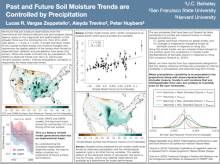Disentangling Contributions to Past and Future Trends in Surface Soil Moisture
Lucas
Vargas Zeppetello
UC Berkeley
Poster
Climate model simulations and various aridity indices generally indicate that summertime surface soil moisture will decrease as a consequence of anthropogenic climate change. However, soil moisture observations from ground probes and satellites that are available between 2011-2020 indicate positive summertime trends across 57% of the Continental U.S. To evaluate the mechanisms driving these trends, we develop a two-layer land surface model that predicts surface temperature and soil moisture on the basis of observed variations in precipitation, solar radiation, vapor pressure, and snowmelt. Of these four model forcings, we show that internal precipitation variability explains the largest fraction of observed soil moisture trends from 2011-2020. Surface air warming and the response of plants to increasing atmospheric CO2 also influence soil moisture trends, but these effects are small at decadal time scales and partly compensate for one another. Looking forward, our results indicate that internal precipitation variability will dictate decadal soil moisture trends and that centennial soil moisture trends will primarily depend upon changes in precipitation that are currently highly uncertain.

Poster file
